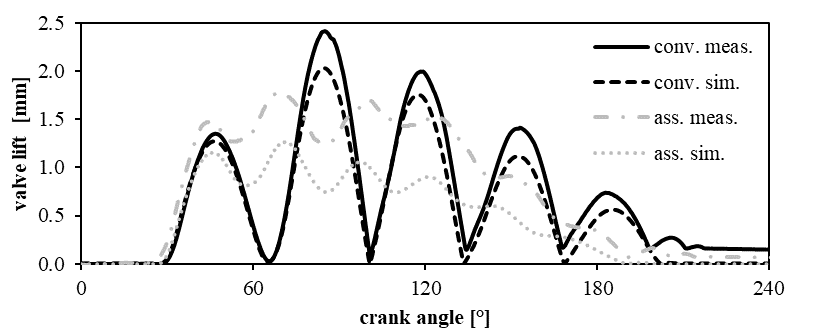EVALD
Entwicklung kraftunterstützter Kompressorventile
Project duration: July 2013 – June 2017
Project funding by: FFG
Project managers: Raimund Almbauer
Project partners: Nidec Global Appliances Austria, IVT
Project team: Andreas Egger, Johann Hopfgartner
Reed valves are widely used in hermetic reciprocating compressors and are responsible for a major share of thermodynamic losses. The suction valve in particular, which is opened for almost the entire suction phase, has a very significant improvement potential. Suction valves in hermetic reciprocating compressors are usually opened only by the pressure difference created by the moving piston and should be closed before the compression phase starts, in order to avoid a reversed mass-flow through the valve. The valves are thus preloaded, which, on the other hand, results in a higher flow resistance.
In this work a force assisted suction valve is investigated. An electromagnetically actuated spring generates an additional force acting on the conventional suction reed valve. This force leads to a completely different valve movement and a significant reduction of the losses caused by the suction valve. A conventional suction valve flutters during the suction phase. Thus, it hits the valve seat several times which has, beside an increased flow resistance, negative influences on the reliability of the reed valve and noise emissions. With the help of the additional force, it is able to overcome the opening delay due to the preload and the oil “stiction” effect. Furthermore, the suction valve can be held open during the whole suction phase, and it closes smoothly in time near the bottom dead centre of the piston.
The investigation of the force assisted suction valve is done by numerical simulations as well as by experiments. Results show an improvement of the coefficient of performance (COP) by approximately 0.7 – 1.6 % depending on the operating conditions.
Preliminary investigations
Valve lift measurements using Laser Doppler velocimetry were made to test the mechanism of the force assisted suction valve and to validate the valve model of the CFD simulation. The measurements were carried on a test compressor without the hermetic upper shell in order to be able to adjust the laser on the centre of the valve plate. The CFD simulation is adapted to this operating condition using air instead of the refrigerant and ambient temperature for temperature boundary conditions as well as ambient pressure for the inlet. Measuring the discharge pressure in the cylinder head gives further information about the correct pressure boundary condition at the outlet. Figure 1 shows the valve lift curves of the conventionally working suction valve (black lines) and the force assisted valve (grey lines). The discharge pressure was regulated to 5 bar. A comparison between the movement of the conventional and the force assisted suction valve shows that the mechanism works and it is possible to open the reed valve earlier, to hold it open during the whole suction stroke and to close it gently. Furthermore, only small deviations can be observed between the simulated and the measured valve lift curve of the conventional suction valve. Beside the amplitude of the curve the flattering frequency in particular can be reproduced very accurately. Larger deviations occur between the valve lift curves of the force assisted suction valve. It would appear that the simulation shows lower amplitudes but a similar frequency of the flattering. This can be explained by the slightly changed alignment of the laser beam. The focus of the laser must be shifted towards the tip of the suction valve, due to the arrangement of the mechanism to generate the additional force. The measured amplitude is thus greater than the simulated one. It can be stated in summary that the simulation model appears to be sufficiently accurate to achieve reliable results.
 |
|
Abb. 1: Saugventilhubkurven aus den Voruntersuchungen |
Simulation Model
3d numerical simulations are performed using the commercial CFD software package Fluent from ANSYS and are based on the work of Hopfgartner et al. The simulation domain, which can be seen in figure 2, includes suction muffler, suction and discharge valve, cylinder, cylinder head and discharge line. The number of cells of the domain varies between 1.9 and 5.2 million cells depending on the position of the piston and the reed valves. The movement of the piston and the reed valves requires a dynamic mesh, which is enabled by using the remeshing, layering and smoothing techniques provided by the software. While the forced piston movement can be modelled easily, the movement of the reed valves must be modelled with a more complex fluid structure interaction. The pressure based coupled solver is applied for the coupling of pressure and velocity. Turbulence is considered with the realizable k-ε model using the enhanced near-wall treatment. Depending on the valve position, the time step varies between 1.4 μs and 17 μs which is equivalent to a crank angle of 0.025 ° and 0.3 ° respectively.
 |
|
Fig. 2: Simulation domain Source: Hopfgartner J, et al.: Reduction of the suction losses through reed valves in hermetic reciprocating compressors using a magnet coil. In: IOP Conference Series: Materials Science and Engineering, Volume 232 (2017), paper no. 012034, pp. 1-10. IOP Publishing. |